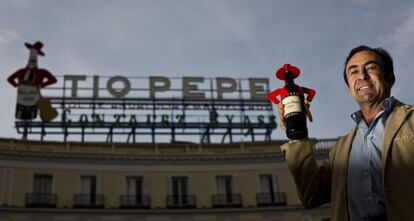“The Tío Pepe sign should never have been allowed to be moved”
The grandson of the iconic sherry logo's creator says Madrid had a responsibility to protect the ad Pedro Pérez-Solero will be there to see the historic sign reinstated in the Puerta del Sol this week

Pedro Pérez-Solero is the grandson of Luis Pérez-Solero, the man who designed the iconic Tío Pepe figure – a sherry bottle wearing a torero jacket and Cordovan hat – that has been the sherry brand’s logo since 1935. In April 2011, the huge neon Tío Pepe sign that had looked over Madrid’s Puerta del Sol for nearly eight decades was taken down during restoration work on the building, which is to become the capital’s flagship Apple Store. Following a petition to return Tío Pepe to Madrid, a building across the Puerta del Sol has signed a deal with the sign’s owner, sherry winery González Byass, to host it. The official inauguration takes place on May 8, and Pedro Pérez-Solero says he will be there to raise a glass to its reinstatement.
Question. Tío Pepe is back in the Puerta del Sol. How would you explain the significance of the advertisement created by your grandfather?
Answer. It has become a Spanish icon. It has been copied by artists everywhere, and is recognized internationally. Tourists come especially to see it… It isn’t really anything special in itself, it’s an advertisement, but it’s part of our culture.
Q. Was your grandfather from the south, from Jerez, where they make Tío Pepe?
A. No, he was born in Burgos, in 1892. He was in his forties when he moved to Jerez, in 1934, when González Byass appointed him head of propaganda, as advertising was called in those days. That was the year the company celebrated its 100th anniversary.
Q. How do you think he got the idea to turn the bottle into a human?
A. I am sure that this happened because he associated Jerez and its wines with art, with joy, with flamenco, and with the sun.
He was a multifaceted artist: he could draw, paint, he was a poet, musician, a bon vivant”
Q. Did your grandfather always work in advertising?
A. He was a multifaceted artist: he could draw, paint, he was a poet, musician, a bohemian, a bon vivant, a drinker, and a man ahead of his time in the world of advertising and communication.
Q. Where did he live before moving to Jerez?
A. He did his military service in Éibar and that is where he met my grandmother, who was Basque. They married and he started working in San Sebastián. He set up a publishing company and started a sports magazine called Gente Nueva (New people). In 1929 he set up one of Spain’s first advertising agencies, Impera.
Q. And then he moved to Jérez. Did he like the city?
A. He fell in love with the place. Its wines, its people, the culture, the atmosphere. He fitted right in. He was involved in anything that had to do with the arts in the city.
Q. Always with a glass in his hand…
A. He was a great drinker. At home he always used to say: “Wine is for drinking, and brandy for selling!”
He fell in love with Jerez. Its wines, its people, the culture, the atmosphere”
Q. Can you think of any slogan of his that still stands out?
A. “Andalusian sun in a bottle.” It says everything you need to know about Tío Pepe. There has never been a better slogan.
Q. He once wrote to Lola Flores, saying: “Your style is beyond copying; it’s love and it’s life, it’s peace and it is war!”
A. He was a fan of hers all his life. He loved flamenco. Somebody once wrote that after hearing a song performed down in the wine cellar, the only way he knew how to show his appreciation was by smashing his glass.
Q. In the first design, the bottle had an arm raised.
A. Yes, but another winery, Sánchez Romate, had a similar image using dogs.
Q. When the Civil War broke out [in 1936] he wrote another poem: “Tío Pepe has a guitar / to hunt the reds…” so he wasn’t exactly left wing…
He always used to say: “Wine is for drinking, and brandy for selling!”
A. No, but he was very open-minded for the times. He was friends with mayors, military men, and bishops. His father was in the army, perhaps that’s where the affinity came from. But he never openly took sides during the war. We never talked about it afterwards. I guess all we have is what he wrote down.
Q. On Thursday, the refurbished Tío Pepe sign is to be turned on. Did you know that there is a campaign to have the sign returned to its original location?
A. It should never have been allowed to be moved. The City Hall had a responsibility to protect it.
Q. Do you still have any relationship with the González family?
A. We used to. My father and my uncle, who were also in advertising, worked for them. They made a famous advertisement with dancing bottles that won a prize. But we lost contact.
Q. Do you get any royalty payments for things sold using the Tío Pepe image?
A. No. My grandfather refused to talk about that.
Q. How old were you when you first tried sherry?
A. Around 14. My father was always faithful to the brands he worked for, and especially Tío Pepe.
Q. And what about you?
A. I like it, but I’m not mad about it. But when I buy sherry, it couldn’t be any other brand.
Tu suscripción se está usando en otro dispositivo
¿Quieres añadir otro usuario a tu suscripción?
Si continúas leyendo en este dispositivo, no se podrá leer en el otro.
FlechaTu suscripción se está usando en otro dispositivo y solo puedes acceder a EL PAÍS desde un dispositivo a la vez.
Si quieres compartir tu cuenta, cambia tu suscripción a la modalidad Premium, así podrás añadir otro usuario. Cada uno accederá con su propia cuenta de email, lo que os permitirá personalizar vuestra experiencia en EL PAÍS.
¿Tienes una suscripción de empresa? Accede aquí para contratar más cuentas.
En el caso de no saber quién está usando tu cuenta, te recomendamos cambiar tu contraseña aquí.
Si decides continuar compartiendo tu cuenta, este mensaje se mostrará en tu dispositivo y en el de la otra persona que está usando tu cuenta de forma indefinida, afectando a tu experiencia de lectura. Puedes consultar aquí los términos y condiciones de la suscripción digital.
Últimas noticias
Most viewed
- Pablo Escobar’s hippos: A serious environmental problem, 40 years on
- Reinhard Genzel, Nobel laureate in physics: ‘One-minute videos will never give you the truth’
- Why we lost the habit of sleeping in two segments and how that changed our sense of time
- Charles Dubouloz, mountaineering star, retires at 36 with a farewell tour inspired by Walter Bonatti
- The Florida Keys tourist paradise is besieged by immigration agents: ‘We’ve never seen anything like this’









































